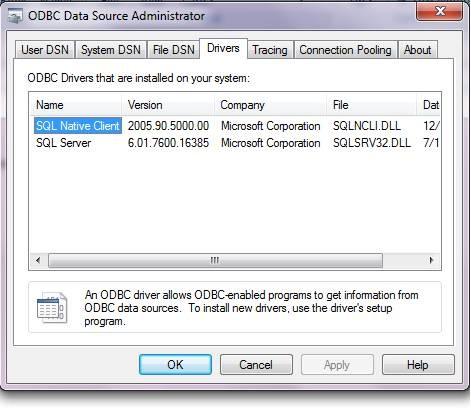Apr 16, 2018 Check the version information that is stored in the registry. Install and Use the Component Checker Tool The most reliable way to determine which version of MDAC is installed is to compare the version number of each MDAC DLL file to a list of the DLL files that are shipped with each MDAC version. The Component Checker can help you to do this. No ODBC Drivers available for Excel or Access! Even after a complete new installation of Windows 7 and Office 2003 professional or Office 2007 professional on another computer. When I want to add a driver in the ODBC Data Source Administrator, the response is: 'T o install new drivers use the driver's setup program!' This article provides commands for installing the ODBC driver from the bash shell. If you want to download the packages directly, see Download ODBC Driver for SQL Server. Microsoft ODBC 17. The following sections explain how to install the Microsoft ODBC driver 17 from the bash shell for different Linux distributions. Alpine Linux; Debian.
- Check Odbc Driver Version
- Check If Microsoft Odbc Drivers Installed Macbook
- Microsoft Odbc Drivers Download
- This topic describes how to use the Windows ODBC Data Source Administrator to check the version of the installed ODBC drivers. To check the ODBC SQL Server driver version (32-bit ODBC) In the ODBC Data Source Administrator, click the Drivers tab. Information for the Microsoft SQL Server entry is displayed in the Version column.
- The Microsoft ODBC Driver for SQL Server can be downloaded and installed using package managers for Linux and macOS using the relevant installation instructions: Install ODBC for SQL Server (Linux) Install ODBC for SQL Server (macOS) If you need to download the packages for offline installation, all versions are available via the below links.
The following instructions assume you already have a SQL Server database running somewhere that your Mac has network access to. Just FYI, Microsoft's instructions for installing the latest drivers are here.
Check Odbc Driver Version
Install FreeTDS and unixODBC
The connection to SQL Server will be made using the unixODBC driver manager and the FreeTDS driver. Installing them is most easily done using homebrew, the Mac package manager:
Edit the freetds.conf configuration file
Ensure the freetds.conf file is located in directory /usr/local/etc/, which will be a symlink to the actual file as installed by Homebrew. Check the specific location of the freetds.conf file by running tsql -C. The default file already contains a standard example configuration, but all you need to do is add your server information to the end, as follows:
There are other key/value pairs that can be added but this shouldn't usually be necessary, see here for details. The host parameter should be either the network name (or IP address) of the database server, or 'localhost' if SQL Server is running directly on your Mac (e.g. using Docker). A TDS version of 7.3 should be OK for SQL Server 2008 and newer, but bear in mind you might need a different value for older versions of SQL Server. For more information on TDS protocol versions see Choosing a TDS protocol version. Do not use TDS versions 8.0 or 9.0 though. Oddly, they are not newer than version 7.4. They are actually obsolete aliases for older TDS versions and their use is discouraged.
Test the connection using the tsql utility, e.g. tsql -S MYMSSQL -U myuser -P mypassword. If this works, you should see the following:
At this point you can run SQL queries, e.g. 'SELECT @@VERSION' but you'll need to enter 'GO' on a separate line to actually execute the query. Type exit to get out of the interactive session.
Check If Microsoft Odbc Drivers Installed Macbook
Edit the odbcinst.ini and odbc.ini configuration files
Run odbcinst -j to get the location of the odbcinst.ini and odbc.ini files (probably in the directory /usr/local/etc/). Edit odbcinst.ini to include the following:
Edit odbc.ini to include the following:
Note, the 'Driver' is the name of the entry in odbcinst.ini, and the 'Servername' is the name of the entry in freetds.conf (not a network name). There are other key/value pairs that can be included, see here for details.
Check that all is OK by running isql MYMSSQL myuser mypassword. You should see the following:
You can enter SQL queries at this point if you like. Type quit to exit the interactive session.
Connect with pyodbc

It should now be possible to connect to your SQL Server database using pyodbc, for example:
Connecting without defining a DSN
If you don't want to define a DSN in odbc.ini, you can reference the driver entry you added to odbcinst.ini.
E.g.:
Note: in this case you may need to specify all necessary TDS parameters in pyodbc.connect.
Connecting without modifying odbcinst.ini or odbc.ini
If you want to avoid modifying both odbc.ini and odbcinst.ini, you can just specify the driver file location in the driver param in pyodbc.connect.
E.g.:
-->Microsoft Odbc Drivers Download
Important
This feature will be removed in a future version of Windows. Avoid using this feature in new development work, and plan to modify applications that currently use this feature. Instead, use the ODBC driver provided by Oracle.
To determine the Oracle components installed on your system (and their versions), navigate to the Orainst directory under the Oracle home directory. Open one of the following text files: Nt.rgs, Win95.rgs, or Win98.rgs.
The file format is similar to the following:
The .rgs files also include installation information and descriptions of each component.